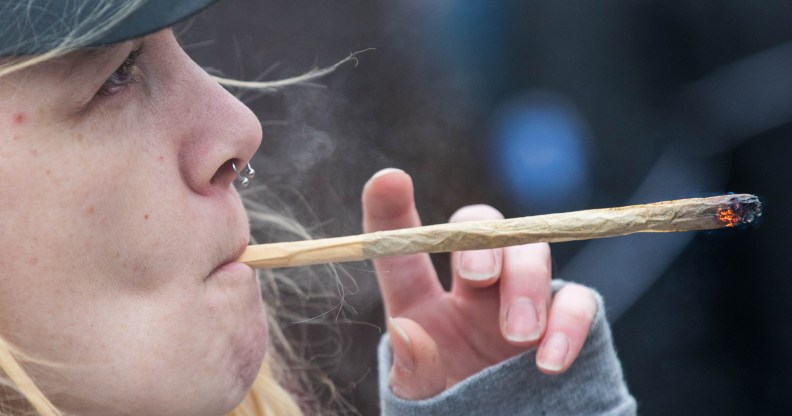Bisexual women seven times as likely to get high per day than straight women, study finds

A woman smokes marijuana during the annual 4/20 rally on Parliament Hill in Ottawa, Ontario, on April 20, 2019. (Photo by Lars Hagberg / AFP) (Photo credit should read LARS HAGBERG/AFP/Getty Images)
Bisexual women are seven times as likely to get high per day than straight women, according to a new study by Columbia University’s Mailman School of Public Health.
It’s thought to be the first study on the relationship between medical marijuana laws, marijuana use and marijuana use disorder for gay and bisexual people while also looking at gender differences.
Of the 126,463 adults surveyed, 40 percent of bisexual women had used cannabis in the past year, compared to 26 percent of gay women and 10 percent of heterosexual women.
Daily use was lower among heterosexual women (1.5 percent) compared to lesbians (6 percent) and bisexual women (10 percent) – making bisexual women nearly seven times more likely to get high each day than straight women.
Researchers speculated that the difference may be a result of the high levels of stigma bisexual women face, which could lead to self-medication with medical marijuana as a coping mechanism for being a sexual minority.
One of the study’s authors, Dr Morgan Philbin, said in a press release: “Our results support existing literature by demonstrating that bisexual women have higher marijuana use disorder compared to heterosexual women.
“This is part of a larger health burden, as bisexual women are twice as likely to have co-occurring mental health and substance use disorders yet often have little contact with service providers.”

A woman smokes a joint at a rally for the depenalization of marijuana in Colombia (Joaquin Sarmiento/AFP/Getty)
The study also found similar results for men, with around 33 percent of gay and bisexual men admitting to using cannabis in the past year, compared to 17 percent of straight men.
And for bisexual men, daily marijuana use was more than twice as high as it was in straight men.
Researchers are now urging policymakers to consider LGBT+ people when regulating cannabis in light of the difference in usage of the drug.
“This study represents an important contribution to the literature on the structural determinants of substance use for LGB individuals and demonstrates the need to allocate resources that target sexual minority women, especially as medical marijuana laws and recreational marijuana laws continue to change at the state level,” said Dr Silvia Martins, the study’s senior author.
“Future surveys that capture how individuals identify will help us pinpoint how state-level marijuana policies may differentially impact specific sub-populations, ultimately advancing the development of more health-promoting policies for all.”

